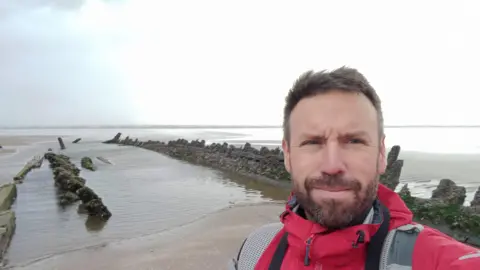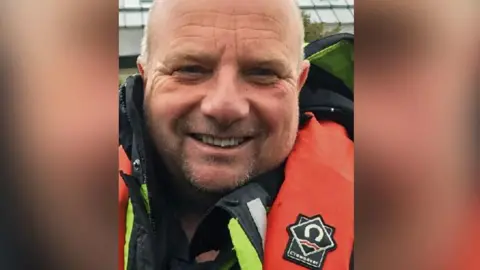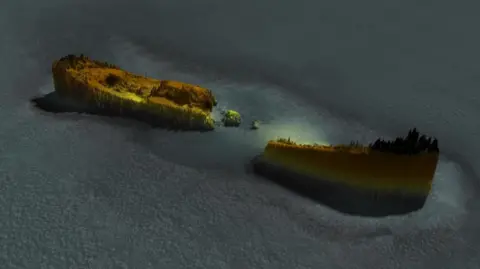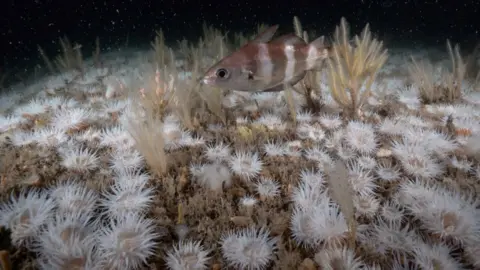Will climate change turn shipwrecks to polluters?
As climate change increases, more extreme storms are created and ocean temperatures rise, meaning shipwrecks - some with fuel in - are degrading fast.
There are more than 10,000 shipwrecks in UK waters, yet two-thirds of these remain mysteries in terms of identity and cargo, said one expert.
Wrecks with fuel remaining onboard could pose serious pollution problems as the metal breaks down.
A marine archaeologist said as these wrecks degrade, "you could have the equivalent of a small oil tanker running aground".
Oil spills can be very harmful to the environment, damaging animals' habitats and polluting the water. They can also be very difficult to clean up.
Dr Julian Whitewright, senior maritime investigator for Royal Commission on the Ancient and Historical Monuments of Wales, said: "When we imagine climate change, we imagine icebergs melting and sea level rise, but it's all of the consequences of that - we've had a record number of storms this year."
He said this affected the coast, stripping beaches of sand, causing coastal erosion which results in landslips into the sea, river channels move, and flooding happens more regularly.
 Dr Julian Whitewright
Dr Julian WhitewrightAs oceans warm, species migrate. If these are marine boring organisms - which eat or bore holes through wood - then shipwrecks may degrade faster, he said.
"Then there's the ongoing process of ocean acidification [where the ocean absorbs more carbon dioxide from the atmosphere when there is an abundance].
"A little change in pH [how acidic or alkaline a solution is] can cause metal, for example, to degrade at a greater rate."
"Every single wreck is unique, it has a story and people who were on it - sometimes are still on it in terms of human remains," he said.
"When one of those sites is destroyed, that's it. It's gone. You can't regenerate a shipwreck."
He said many of the wrecks in Welsh waters were from both world wars, with some having run on coal, and others on oil.
"If they suddenly collapse because they've undergone really bad structural degradation, you could have the equivalent of a small oil tanker running aground in terms of the release of oil."
To mitigate this environmental risk, researchers first have to know what each ship was fuelled on and was carrying.
But there is a problem: the true identities of all the wrecks are not known.
 Dr Michael Roberts
Dr Michael RobertsDr Michael Roberts, from Bangor University has been managing marine survey projects and called the lack of certainty on shipwreck identification "a shocking state of affairs".
"Nobody's talking about it - it's out of sight, out of mind," he said. "I don't think everyone realises that we don't know what's there."
Shipwrecks have historically been identified with limited data, so when he and his team survey them, they often discover new wrecks or that the prior identification is wrong.
He said the "error is massive" because, of the wrecks with names, "we’re talking about a third unknown, a third that are wrong and a third that are right but we don’t know which."
"Until you survey them all, you can’t say with real certainty what’s what."
 Bangor University
Bangor UniversityDr Roberts and his team have surveyed 650 UK registered charted shipwreck sites.
"I've surveyed all of the wrecks in Wales apart from a dozen off Pembrokeshire and if I could just get them, Wales would be the first country in the world to have inventoried its entire maritime heritage. But there’s no funding," he said.
Dr Roberts said: "The survey work needs to be done with a cost effective ship that can stay out for several days on end and have the latest sonar system on board - Wales has one... it's called the Prince Madog and is based at Bangor University's School of Ocean Sciences - along with people who know how to do it."
"In 40 or 50 years time these wrecks will be indistinguishable lumps of material on the seabed. They’re collapsing now, the clock's ticking."
 CloudBase Productions Ltd
CloudBase Productions LtdTo protect wrecks from climate change, they need to be buried in sand, said Dr Whitewright.
"It can't be eroded, it can't be eaten, it can't be broken. It's that process of stuff getting exposed that causes the damage."
Sometimes these sites are covered in sand bangs to protect them, but recently a project looking at regenerating seagrass has found a new solution.
Project Seagrass is aiming to plant different species across 10 hectares of north Wales - and it just so happens that several wrecks are within this area.
Dr Whitewright said: "Seagrass acts to trap sediment, build up the seabed and you can have a wreck effectively buried."
